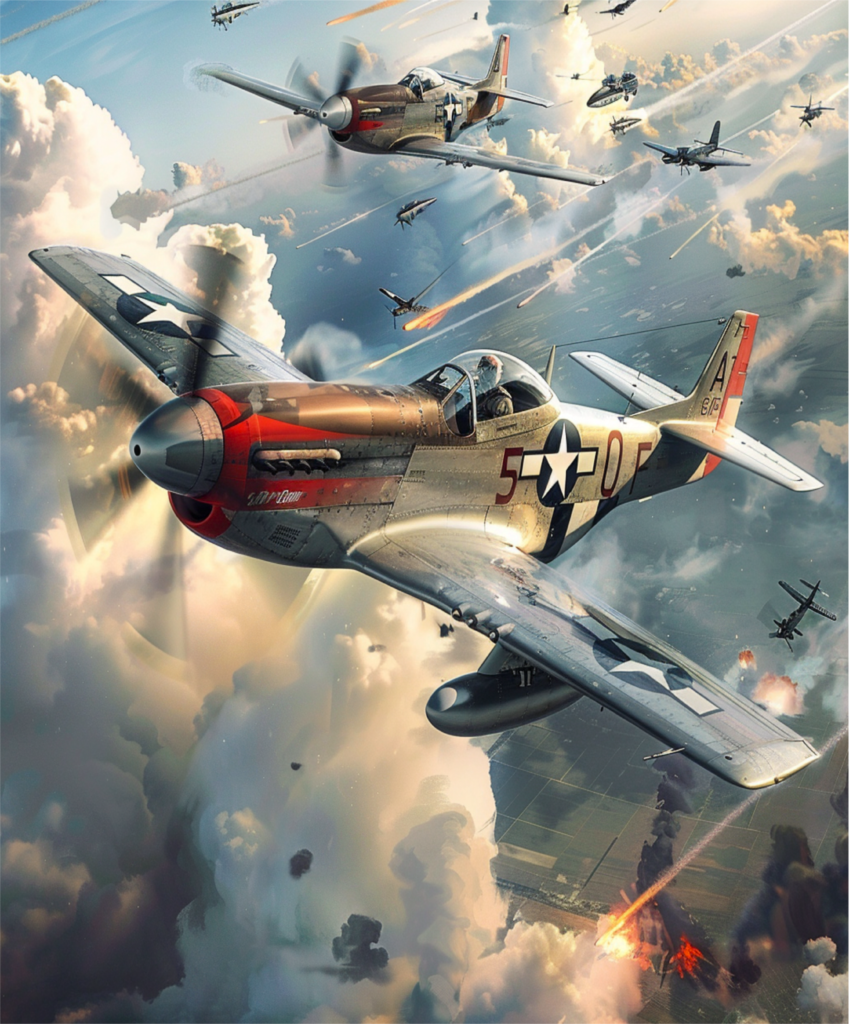
P-51 MUSTANG
The P-51 Mustang is one of the most iconic fighter aircraft of World War II, renowned for its performance, versatility, and impact on the Allied air campaign.
Development and First Flights
**Design and Development:**
The P-51 Mustang was designed by North American Aviation (NAA) in response to a British request for a new fighter aircraft. The initial design, known as the NA-73X, was completed in just 102 days.
**First Flight:**
The prototype NA-73X made its maiden flight on October 26, 1940. The aircraft initially featured an Allison V-1710 engine, which limited its high-altitude performance.
Key Improvements
**Merlin Engine:**
The significant transformation came when the aircraft was fitted with the Rolls-Royce Merlin engine (specifically, the Packard-built Merlin V-1650-3). This engine dramatically improved high-altitude performance, range, and overall combat effectiveness.
**Variants:**
The most notable variants included the P-51B/C (the first with the Merlin engine) and the P-51D, which featured a bubble canopy for improved visibility, increased firepower with six .50 caliber machine guns, and additional fuel tanks.
Specifications (P-51D Mustang)
**Engine:** Packard V-1650-7 Merlin
**Power:** 1,490 hp (1,111 kW)
**Max Speed:** Approximately 437 mph (703 km/h) at 25,000 feet (7,620 meters)
**Range:** Up to 1,650 miles (2,655 km) with external fuel tanks
**Service Ceiling:** 41,900 feet (12,800 meters)
**Armament:**
– Six .50 caliber M2 Browning machine guns
– Up to 2,000 pounds (907 kg) of bombs or 10 HVAR (High Velocity Aircraft Rockets) rockets
Operational History and Campaigns
**European Theater:**
The P-51 Mustang played a crucial role in gaining air superiority over Europe. It was extensively used for long-range bomber escort missions, ensuring the safety of bombers such as the B-17 Flying Fortress and B-24 Liberator during daylight raids over Nazi-occupied Europe. Its ability to escort bombers deep into enemy territory was a game-changer.
**Pacific Theater:**
The P-51 also saw service in the Pacific, where it was used for long-range missions, including raids on Japanese targets and close air support for ground troops.
**Notable Campaigns:**
**Operation Pointblank:** Strategic bombing campaign aimed at crippling German industry and air power.
**D-Day (Operation Overlord):** Provided crucial air cover and ground support during the Allied invasion of Normandy.
**Operation Market Garden:** Supported the Allied airborne operations in the Netherlands.
Impact and Achievements
**Aircraft Shutdowns:**
The P-51 Mustang was credited with destroying approximately 4,950 enemy aircraft in the air during World War II, making it one of the most successful fighters of the conflict.
**Versatility:** Besides air superiority missions, the Mustang was used in various roles, including ground attack, reconnaissance, and interdiction.
**Post-War Service:** The Mustang continued to serve in various air forces around the world post-WWII and saw combat in the Korean War. It remained in service with some air forces into the 1980s.
Legacy
The P-51 Mustang is celebrated for its outstanding performance, pivotal role in achieving Allied air superiority, and contribution to the eventual victory in Europe. Its blend of speed, range, and firepower made it one of the finest fighter aircraft of its era, and it remains a symbol of American aviation excellence.




